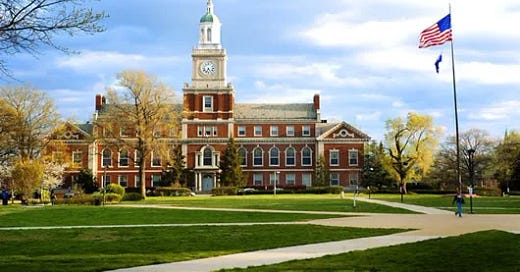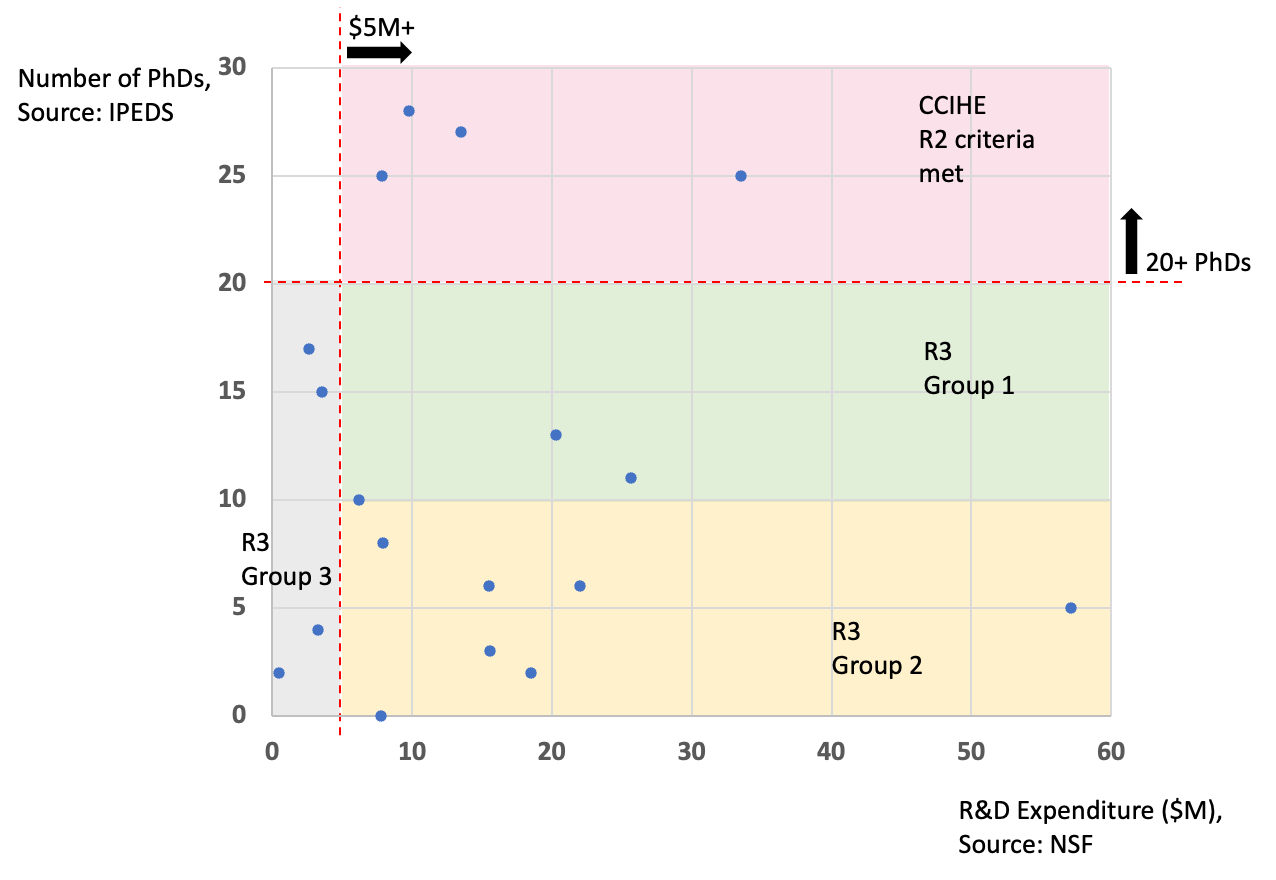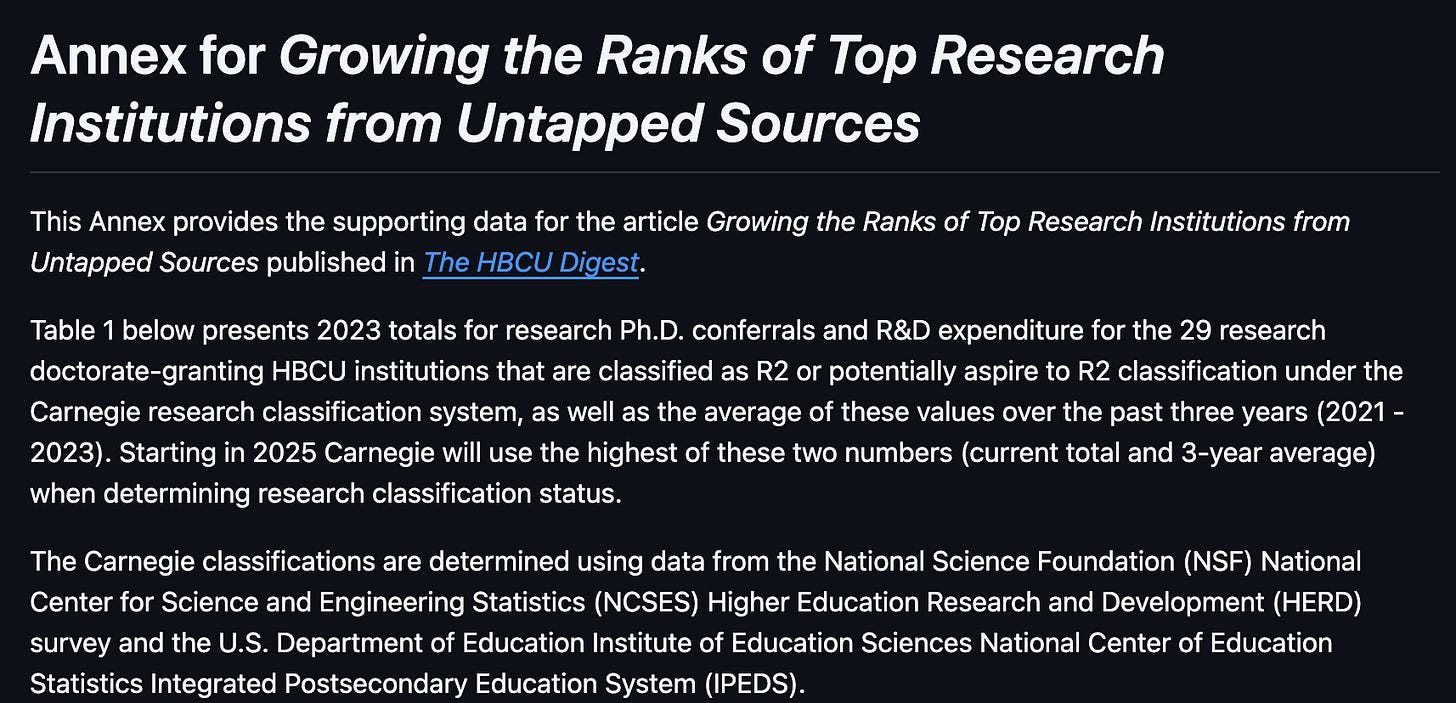Howard's R1 achievement is great. HBCU R2s may be an even greater story
By: Jaret C Riddick and Brendan Oliss
Recently released data indicates that the nation’s historically black colleges and universities (HBCUs) should be amplified as drivers of economic prosperity and national security. Much has been made lately of HBCUs poised to achieve the top-tier “R1” classification from Carnegie Classification of Institutions of Higher Education (CCIHE), including congressional legislation focused on increasing defense research capacity of minority-serving institutions.
However, new data shows research capacity growing across the HBCU research and development (R&D) landscape, even for schools not in the running for coveted R1 classification. This expanding research capacity is proof that these emerging research HBCUs are poised to increase the pace of growth of America's innovation economy, contribute to the expansion of resilient communities in some of the nation’s hardest hit areas, and expand defense research capacity critical to national security.
Policymakers and Congress should capitalize on this windfall of strategic and economic benefits not fully anticipated by recently enacted legislation.
As recently as 2015, the Carnegie classifications of research institutions included 334 PhD-granting colleges and universities classified as R1, R2, and R3, with these categories roughly divided into thirds; about 110 schools in each category. The top-tier R1 classification is reserved for research institutions that engage in “very high research activity”, while R2 classification denotes “high research activity”. Both are noteworthy distinctions but the R1 status is regarded as the gold standard. Gaining R1 designation elevates institutions in terms of attracting funding, full-time teaching faculty, doctoral students, and post-doctorates. New criteria proposed for 2025 will re-define R1 institutions as those that grant 70 or more research doctorates with $50 million dollars or more in research and development (R&D) expenditures, all in one year. No 2025 changes are proposed for the R2 criteria which will continue to recognize institutions that grant 20 or more research doctorates with $5 million dollars or more in R&D expenditures in a year.
As of the latest update just announced this week, Howard University is among the 187 R1 institutions. With this history-making announcement, Howard becomes the only HBCU among R1 institutions, regaining the R1 status it once held until a CCIHE rules change in 2005. In addition, the number R2 HBCUs rose from 11 to 14 of the 139 R2 institutions in this 2025 update. The “R3” designation is no longer a formal category in Carnegie classification today. However, the R3 moniker endures as a popularly used reference to “R2-aspiring” institutions that engage in quality PhD-level research but have not achieved the thresholds for R&D expenditure and research PhDs conferred for R2 classification. Georgetown University's Center for Security and Emerging Technology recently completed a study on the impact on R2 HBCUs pursuing R1 status due to the changes in 2025 for the CCIHE classification criteria, but what about the fate of the R3 HBCUs?
Analysis of newly available data reveals that there are a number of R3 HBCUs primed to swell the ranks of R2 HBCUs. Some of these R3 institutions will achieve R2 status in the recently announced 2025 update. For others, small increases in R&D expenditure could reap significant return-on-investment by growing the number of R2 institutions. In order to accelerate the output of highly skilled talent and expand research expertise required to maintain U.S. standing in global competition, leadership and policymakers should place new focus on growing the number of R2 HBCUs from eligible R3 institutions. Policies focused on these gains in talent and research mean more opportunities for innovation, commercialization and entrepreneurship in the communities where these HBCU institutions reside, broadening the economic stability required for strong national defense.
“R3” HBCU Progress Shows Great Promise
Figure 1 below shows the 2023 totals of R&D expenditure and research PhDs conferred for the 18 R3 HBCUs (the data supporting Figure 1 can be in Table 1 below, and here on GitHub). The dotted lines represent the respective thresholds for R2 classification – 20 research PhDs conferred and $5 million in R&D expenditure. The points on the plot fall within shaded regions as follows:
Pink for R3 HBCUs that meet the CCIHE requirements for R2;
Green for those on the cusp of achieving R2, which we refer to as “R3 Group 1;”
Yellow for those that have to increase the number of research PhDs conferred by 10 or more to reach the R2 threshold, “R3 Group 2;”
Gray for those that must increase both the number of research PhDs and R&D expenditures to reach R2 status, “R3 Group 3”.
Figure 1 shows four data points that fall within the “CCIHE R2 criteria met” region (shaded pink): Delaware State University, Hampton University, South Carolina State University and Virginia State University. These four schools appear to be poised to announce new R2 status in the 2025 CCIHE update. Note here that Hampton University was previously designated as an R2 university from 2018 until 2021. Among these institutions, policy focus should be placed on strategies to sustain this new status well into the future.
Figure 1. R&D Expenditure and Research PhD Production for R3 HBCUs (2023)
Source: https://ncsesdata.nsf.gov/builder/herd.; National Center for Education Statistics, “IPEDS Integrated Postsecondary Education Data System: Custom Data Files.”
Additionally, data for R3 Group 3 (shaded gray in Figure 1, with less than $5M in R&D expenditures) show that two schools, Bowie State University and Fayetteville State University, surpassed 10 research PhDs conferred in 2023. In fact, small increases in the R&D expenditure of these two schools to the $5M threshold would immediately place them into the category of “on the cusp” of R2 status, along with three members of R3 Group 1 (shown in green shaded region of Figure 1), Norfolk State University, Tuskegee University, and University of the Virgin Islands. For R3 HBCUs with greater than 10 research PhDs that surpass the $5 million threshold, near term strategy to reach R2 status should be placed on reaching the threshold of 20 PhDs, and then charting a course to sustain or grow this level for the future.
The Impact of HBCU Research Aspirations
Several R3 HBCU institutions are within reach of R2 status. At least four already appear to meet the criteria, which would bring the total to 14 R2 HBCUs at the next update of the CCIHE classifications expected in 2025. Analysis of promising new data also indicates that small increases in R&D expenditure would push at least 5 more to the verge of R2 status, where strategies to grow PhD production can be established. Ultimately leadership and policy makers should expect that these gains in HBCU research capacity will yield highly skilled talent from untapped populations and unexpected sources. The recent CSET study cited earlier concluded that for the majority of the R2 HBCUs reaching the R1 threshold ($50M+, 70+ PhD) would have to be considered a long term goal. However, near-term, smaller investments can grow the ranks of R2 HBCUs from eligible R3s at an accelerated pace to grow the overall HBCU R&D capacity in the meantime.
According to a Goldman Sachs report, HBCUs are frequently situated in areas with a large number of low-income Black families and contribute greatly to the economic stability of these communities. Their influence on upward mobility is so strong that just living near one boosts the likelihood of college graduation. Continued growth in HBCU research capacity provides an added benefit for local economies. According to another recent report from Andrew W. Marshall Foundation, mechanisms, networks, or incentives to drive research programs toward tangible benefits at the local and regional level are lacking, leaving valuable research ideas that could be used to satisfy real-world problems to “die on the vine.” HBCU research often focuses on subject areas intended to make the communities where they exist thrive, such as sickle cell disease, diabetes and hypertension research, food security, and financial literacy. Because of this focus, gains from HBCU research can serve as “connective tissue” between the innovations produced by research funding and improving the quality of life, community resilience and economic well-being of the communities where they exist.
Finally, ensuring the United States maintains the edge in technology and talent will be crucial in the emerging great power competition with Russia and China. America is falling behind in producing critical talent in science, technology and mathematics (STEM), and concern is growing that capable adversaries could surpass the United States in emerging technologies such as AI, robotics, and hypersonics. For years the Congress has recognized the strategic importance of the nation’s historically black colleges and universities (HBCUs), a group of 101 schools that produce 25% of the nation’s Black STEM graduates. Understanding the growing R&D capacity of these emerging research HBCUs will help decision makers to decide how best to invest to build the R&D capacity of these already over-performing institutions as a key U.S. strategic asset in the emerging geopolitical competition.
(Source: “Table Builder | NCSES | NSF.” https://ncsesdata.nsf.gov/builder/herd; National Center for Education Statistics, “IPEDS Integrated Postsecondary Education Data System: Custom Data Files.”)
Dr. Jaret Riddick is a Senior Fellow at Georgetown University’s Center for Security and Emerging Technology.
Brendan Oliss is a student research analyst at Georgetown University’s Center for Security and Emerging Technology.





